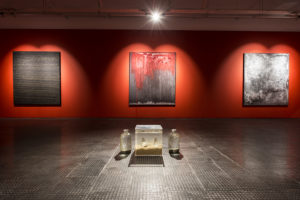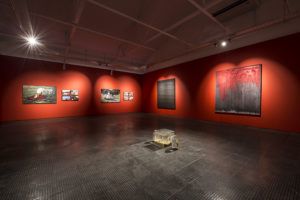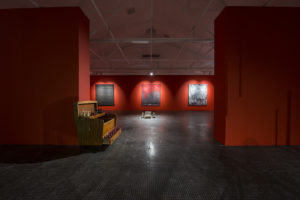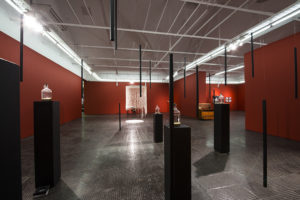
By engaging African ritualistic elements in order to invoke themes of historic healing, the artist demonstrates the measure with which what is perpetual about the moral putrefaction that characterizes society is persevered by what is ambiguous between the play of history and time, and between historic moments and contemporary examination.
Themba Tsotsi on the last exhibition of Lhola Amira
Lhola at the opening of the exhibition
Lhola Amira and the Mendi
Lhola Amira made an appearance at the Smac Gallery in an event that demonstrates spiritual magnanimity is fruitful through creative expression. The exhibition titled “SINKING: Xa Sinqamla Unxubo” deals with history as a facility of healing and embodying it and exposing the contemporary as that which harbors the wounds of the past instead of healing them. At the heart of this exhibition is a desire to discourse African history in a measure that invokes the past as a facility for healing and bridging the divide between what is contemporary and historic. The S.S. Mendi was a boat that carried South African soldiers who participated in the Second World War, 607 South African Native Labour Contingent member died when the ship drowned on the 21 February 1917. Lhola Amira usually concerned with the significance of her presence during a performance with this exhibition audience participation became significant playing the role of witness to her presence and witness to the wounds she discourses. Is figure that embodies the ambiguity between history and the contemporary through her presence and her spiritual activities. History being the facility that renders her work spiritual and divine without the clouded perspectives of contemporary culture and ambiguity of contemporary history. The contemporary being the facilities with which she is able to invoke notions of healing, through the difficulty of discoursing the wounds.

Installation view, 2018

Installation view, 2018.
Titled SINKING: Xa Sinqamla Unxubo, a title that espouses the notion of severance that historical colonialism has subjected contemporary South Africans to. This exhibition highlights how Africa has been written out of the grandeur that 20th century general history is defined and characterized by. By engaging African ritualistic elements in order to invoke themes of historic healing, the artist demonstrates the measure with which what is perpetual about the moral putrefaction that characterizes society is persevered by what is ambiguous between the play of history and time, and between historic moments and contemporary examination. What is implicit is the sense or measure of inevitable preservation that history is organically subject to. This is reflected in the use of storage trunk, bottle with water and sand at their bottoms.

Installation view, 2018.
The artist invokes the violence of preserved or disintegrated bodies at the bottom of the ocean. She is conscious of the connotations of cleanliness that are inherent in matters related to the sea, but the context that she examines in this exhibition is historically imbued with a sense of violence that is symbolized by the violent context and subsequent neglect that the passengers of the Mendi were subjected to during their experience. Since it is the African body that has been written out of history, the exhibition examines how the contemporary African body relates to history, as if she is a water bottle containing beach sand and it’s the connotations of emptiness and anonymity in relating to the sea.

Installation view, 2018.
By putting water and sand into a bottle, is a strategy that seeks to demonstrate how the individual bodies that drowned with the Mendi are still imbued with a measure of power, it might be only symbolic, but it is also that which creates a sense of place in relation to each individual and body on that boat. The instillation with the bottles on black rectangular tubes is a piece that captures this implication the most. The tubes and the bottles are scattered and deliberately imbued with individuality, this not brings to mind the desperate places they each emanated from, but it is also a piece that demonstrates the measure with which the collective black body becomes imbued with historic significance in retrospect. The bottle are not only symbolic of the individuals that were passengers on the boat, but they are also symbolic of the individualities that drowned and disintegrated, it is a somber and elegiac piece consistent with the connotations of healing and commemoration that discourse around the Mendi resound with. It is a piece that seeks to articulate the sense of individual portraiture in absentia; it is also a piece about the lack of closure for the individuals that drowned and the future progeny that is affected by the Mendi as an historic moment.


Amakhosi KaMendi (details), 2018
The image of preserved history in order to incite implications for healing is articulated in the piece titled Amakhosi KaMendi, a piece in which miniature replica figures of Lhola Amira rendered in different colors, red, black and gold with the interior of the trunk filled with diamonds the figures carrying sticks and specters. Their gestures characteristic of the effeminate postures that Lhola Amira is famous for, are executed in this way in order to articulate the sense of divided continuity the violence of the war has subjected the world to. This way the exhibition is not about a sentiment of violence and war, but the disparity between Lhola Amira’s alternative womxn gender enables this disparity to be imbued with a measure of the personal for Lhola Amira and a measure of legacy for the individuals that drowned in the ship.

The artist at the opening.
The artist has also incorporated photography in the exhibition, continuing Lhola Amira’s strategy to discourse notions of representation and identity formation. In this context Lhola Amira is at a coronation ceremony, the white she adorns in this ceremony is testament to the sentiments of healing that are complicit with the themes of the exhibition. Her companions accompany her to the sea or river that African ancestry associated with, the motif of drowning and being allowed to depart to the land of the departed elders becomes imbued with a measure of narrative through the S.S. Mendi. Like the nature of coronation ceremonies it resounds with the goals of individual realization and reconciliation between those who have passed on and those that continue their legacies. The presence of Lhola Amira and water in this exhibition play a symbolic role related to healing and is consistent with implication of ‘looking for Africa in Africa’. This way the connotations of cleanliness are not just symbolic they are also practical imbued with spiritual connotations of sacrosanct spaces and how one relates to them in their physicality.

Installation view, 2018
What is being cleansed is the preserved putrefaction in the symbolic waters of the country and those who have inherited the legacy and tragedy of the S.S. Mendi. The photos are also augmented by abstract pieces, one rendered on a black background with a white substance; another is red and black with the red dripping from the top resulting in an image that suggests movement like water but also preservation for future generations.
